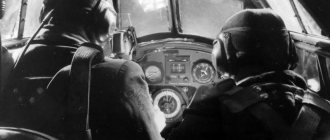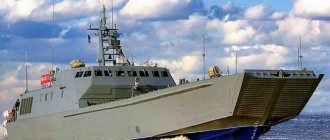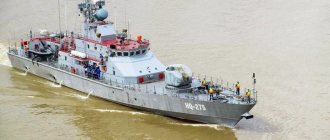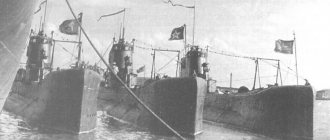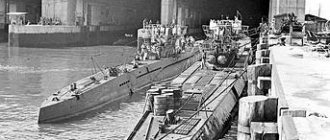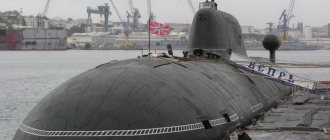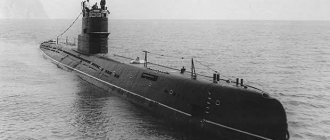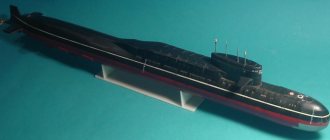Submarines capable of carrying aircraft
Submarine aircraft carriers are special combat vessels designed for the underwater relocation of aviation forces to other parts of the globe for reconnaissance and attack operations. The design of this type of ship began a little over a century ago. Nowadays, the construction or use of such ships is not relevant. However, who knows where our imagination and technological progress will lead us. Therefore, it cannot be ruled out that the naval powers will once again take up the aircraft carrier submarine project.
History of creation
The late nineteenth and early twentieth centuries were a clear leap in naval technology. The integration of the surface fleet with aviation did not stop there. Many powers of that time wanted to combine aviation with a submarine fleet, and as a result, the first submarines appeared with the ability to transport aircraft on board. True, these “planes” were not the same planes that we see today. At first these were seaplanes, then, with improved technology, they were transformed into kite gyroplanes, seaplanes and airplanes.
Submarine U-12
The first analogues of underwater aircraft carriers appeared in the first quarter of the last century in Imperial Germany. In pre-war times, the Germans were looking for leverage in the war that was about to begin. Obsessed with expanding the borders of his empire, William II paid special attention to the naval forces because... the presence of Great Britain in the ranks of the enemy could lead to disastrous results if nothing was done in this aspect.
The first underwater aircraft carrier (if, of course, it can be called such) was an ordinary submarine U-12, on board which was attached an aircraft lifting/lowering crane and special mounts for the Friedrichsrafen seaplane.
Thus, in 1915, the first launch of a seaplane was carried out by a submarine for reconnaissance of the British coast. However, the submarine could only transport a seaplane in a surface position, which forced engineers to build a special hangar for aircraft. As a result, in 1917, the U-12 submarine had a hangar completed. The first aircraft taken into the hangar was the Brandenburg reconnaissance seaplane of the FF-29 class. However, due to the defeat and harsh conditions of the Versailles Agreement, Germany abandoned this project.
Submarine aircraft carriers between "I" - "II" World Wars
After the First World War, a number of countries became interested in the idea of “submarine aircraft carriers”: Great Britain, France, the United States, the Soviet Union, Nazi Germany and Imperial Japan. America again plunged into the Monroe Doctrine, as a result of which it did not devote much effort to the development of this topic (the topic did not advance beyond the tests on the S-1 submarine). In the newly formed USSR, the first project of a “submarine-aircraft carrier” was proposed only in 1935. S. Bazilevsky's project included submarine cruisers, battleships and aircraft carriers that could transport from 1 to 16 units of reconnaissance aircraft, fighters and bombers. However, the command of the Red Army Naval Academy rejected the project due to the fact that it did not have an economic, tactical and military justification.
The rest of the listed countries were more persistent in this matter, as a result of which they achieved results. Imperial Japan was especially successful with the idea of “submarine aircraft carriers.”
Links[edit]
- Treadwell, Terry C (2010). German and Austro-Hungarian aircraft builders 1908-1918
. ISBN 1445637022. - Flightglobal Archive - Aviation History - Flight, July 31, 1931 (pp. 759-763)
- "New Collapsible Plane for Submarines", February 1931, Popular Science bottom of page 33
- "Airplane Folds into a Tube to Fit a Submarine" Popular Mechanics, April 1931,
p. 535 - "Flat Folds to Fit Space on a Submarine" Popular Science
, June 1933, bottom of page 14 - Friedman, Norman (1994). US Submarines Since 1945: An Illustrated History of the Design
. Annapolis, Maryland: United States Naval Institute. pp. 178–182, 262–263. ISBN 1-55750-260-9. - ^ ab Layman, RD; McLaughlin, Stephen (1991). Hybrid warship Combining large caliber guns and aircraft
. Conway Maritime Press. pp. 182–184. ISBN 0-85177-555-1.
French submarine aircraft carrier Surcouf
After the terrifying consequences of the First World War, it was decided to reduce and limit the amount of military equipment. In the ship plan, the “London” Treaty was signed, according to which restrictions were adopted on displacement, weapons and their quantity. Countries began to look for loopholes to circumvent the adopted agreement. Due to the fact that the treaty mainly focused on surface technology, the countries decided to use underwater technology. France was one of these countries. France placed its emphasis on powerful submarines in 1927.
Submarine aircraft carrier Surcouf
Submarine cruisers began to be built in the same year, 1927, in the amount of 3 units. However, due to the toughened clauses of the new London Treaty, according to which the artillery caliber of submarines should not exceed 155 mm, in 1929 only 1 submarine cruiser was completed, which had an artillery caliber of 203 mm (Surcouf was an exception for France under the treaty ). It entered service with the French Navy in 1932.
"Surcouf" became the greatness of the French Navy. It was huge, displacing 4,300 tons. Thanks to its artillery gun, it could hit any surface targets; 20 torpedoes made it possible to hit underwater targets; as well as the Besson BM410 reconnaissance seaplane made it possible to see much beyond one’s capabilities. "Surcouf" repeatedly visited the ports of other countries to demonstrate the power of the French Navy.
With the quick surrender of France in World War II, the submarine cruiser, along with the rest of the ships of the French fleet, fell into the hands of the British and was then redirected to the United States. Due to its endless malfunctions, the submarine moved from one port to another. During one of these passages to Tahiti from a port in Bermuda, the Surcouf went missing in the waters of the Caribbean Sea. According to official data, the submarine sank due to its malfunctions, but French historians are still investigating this topic.
British submarine aircraft carrier "M-2"
Britain has achieved less success than its Channel neighbor France. In 1927, the Royal Navy converted its old M-2 submarine into an underwater aircraft carrier, replacing the 305 mm artillery mount prohibited by the London Agreement with a hangar that was 3 m in diameter and 7 m long. For the underwater aircraft carrier, it was decided to build special Parnel Peto seaplanes, whose main task was to scout enemy territories where other groups could not reach. However, the low test results of the aircraft carrier did not inspire much hope among the naval command. In 1932, during one of the exercises, which became the last for the M-2, the submarine sank in the Portsmouth area. The main assumption of the incident is the premature opening of the submarine's hangar door. After this turn of events, Great Britain abandoned the idea of submarine aircraft carriers.
Submarine aircraft carrier M-2
Submarine aircraft carrier M-2
Submarine aircraft carriers of Nazi Germany
There was no limit to Hitler's "crazy" ideas. In the late 1930s, the Germans again took up the aircraft carrier submarine project. The project was to build two different types of such aircraft carriers - classes "III" and "IX". However, over time, the first one was abandoned because she was the prototype of a submarine cruiser during the First World War. Class IX submarines had a hangar on board with a diameter of 2.25 m. In 1939, a special seaplane “Arodo-231” was planned for the hangar, which took 10 minutes to take off. A budget was allocated for the project, but the outbreak of war changed the plans of the Nazis. Deviating from this path, Germany refused to build special seaplanes and replaced them with snake-gyroplanes of the Fa-330 class, which were tied to a submarine. Autogyros weighing 200 kg. (together with the pilot), began to be built in 1943.
It took 7 minutes to fully prepare the kite for takeoff, and it took about 3 minutes to climb the tethered kite, which could rise to a height of up to 150 m and monitor enemy actions. It took a total of 12 (10+2) minutes to land on the deck and assemble the gyroplane. A year later, the Fa-336 was designed, which had its own engine, which made it easier to control snakes. However, the Fa-336 was never able to go through serial production due to the decline of Nazi Germany, which, in principle, ended the history of submarine aircraft carriers in Germany.
Content
- 1 Early history (World War I)
- 2 Between the wars 2.1 France
- 2.2 Italy
- 2.3 Japan
- 2.4 United Kingdom
- 2.5 US
- 3.1 Germany 3.1.1 Type IX D 2- “Monsun”
- 3.2.1 Type B1 (20 pcs.)
,
I-14
)
,
I-401
,
I-402
)
Submarine aircraft carriers of Imperial Japan
The Imperial Japanese Navy was the last to come to the theme of “submarine aircraft carriers”, but became the most successful. The first Japanese project was built in 1932. It was not a large I-5 submarine of the J-1M type, with a special hangar and a lifting/lowering crane attached to the deck. The I-5 used the German Gaspar U-1 seaplane, which the Japanese had built under license back in the 1920s. However, due to the fact that the I-5 had a number of shortcomings (the lack of a catapult and springboard, problems with the crane and the quality of the hull itself), the J-1M type submarines were no longer built.
The J-1M was replaced by the J-2 type with the I-6 submarine built in 1935. A special aircraft of the “E9W” type was created for the submarine. The new submarine aircraft carrier had great advantages over its predecessor in many aspects, but still did not become what the command of the Japanese fleet was looking for. The main reason for the dissatisfaction was the lack of a springboard and catapult on the submarine, which reduced the take-off speed of the aircraft. As a result, submarine aircraft carriers of the J-2 type remained in one copy.
The beginning of 1939 was a success for Japanese engineers. The first submarine aircraft carrier “I-7” of the “J-3” type was created, which had a catapult and a springboard on board (the main disadvantage of the “J-2”). The aircraft carrier was lengthened, which made it possible to build a hangar for 2 aircraft. The main aircraft were the Yokosuka E14Y type. The E14Y was much better than its predecessors, and its main feature was that it was not only a reconnaissance aircraft, but also a bomber. Of course, it could not compare with the main bombers of Imperial Japan and had a rather small supply of bombs, but still it was the first bomber aircraft used on submarine aircraft carriers. Later, another submarine of this type, I-8, was launched into the water.
After the "J-3" came the "A-1" type in a series of 3 ("I-9", "I-10" and "I-11") units. The last 2 appeared after the successful actions of I-9 in obtaining photographs from Pearl Harbor.
Japanese aircraft carrier submarines underwent constant modernization, the types “A-2”, “B-1”, “B-2”, “B-3” and “B-4” appeared, the total number of which exceeded 20 units. I would not say that their differences were great, it was just that their equipment and weapons were being improved; The only constant remained the Japanese aircraft used - the E14Y.
I think it is necessary to emphasize one more fact that during the two world wars, the American continent was bombed only once. This bombing was carried out by a Japanese Navy E14Y aircraft. The plane was supposed to cause massive forest fires in Oregon, but something went wrong and the bombs did not have the expected effect. However, it certainly shocked the entire American people.
I-400 class submarine carrier
Despite the fact that this is also a Japanese type of underwater aircraft carrier, I decided to give it special attention. There are 2 simple reasons for this:
- "I-400" were the largest submarines before the advent of nuclear submarines.
- Modern technologies "I-400" were an example of the creation of a nuclear submarine.
The unsuccessful bombing of Pearl Harbor and major defeats in naval battles derailed Imperial Japan's plan. Japan needed a new weapon that could change the outcome of the war. Due to the weakening of the Japanese, the surface fleet of the country of the “rising sun” could not approach the shores of America. For this task, engineers began to work on a weapon that would have the effect of surprise and a powerful force of destruction - a huge submarine - an aircraft carrier, with the ability to transport at least 3 aircraft (unassembled); have on board artillery and torpedoes of a high level of destructive power; have enough resources to reach any point in the world while underwater for up to 90 days. The embodiment of these requests was the underwater aircraft carrier I-400.
“I-400” had a displacement of 6,500 tons, length – 122 m, width – 7 m, immersion depth – 100 m, autonomy – 90 days, maximum speed – 18 knots, crew – 144 people. It was armed with 1 140 mm artillery gun, 20 torpedoes and 4 25 mm ZAU. The submarine's hull resembled the number "8". This type of housing was created for convenient storage of fuel and supplies. The hangar was 4 meters in diameter and 34 meters long.
The Aichi M6A Seiran aircraft was designed and built especially for the “underwater giant,” which could carry up to 2 bombs of 250 kg or 1 bomb of 800 kg. The aircraft's range was 1200-1500 km, depending on whether the aircraft had a float or not. The float was the only detachable part of the aircraft because... without it, the plane flew 100 km/h faster and 300 km further. Moreover, during combat operations, the aircraft were planned to be launched without a float in order to save launch time. Thus, without a float, the planes took off in 14.5 minutes, with a float - 30 minutes.
The main objective of the Japanese “miracle” was to bomb strategically important US locations. The plan included New York, the Panama Canal and other American strategic points. The highlight of the attack was the surprise of the operation. A flotilla of submarine aircraft carriers was supposed to attack the continent of the “new world” from the Atlantic. The route was laid across the Indian Ocean to the southern shores of Africa (Cape of Good Hope), from where the flotilla could head to its destination across the Atlantic basin.
Operation Hikari
In connection with the situation in 1945, the government of the Empire of Japan reconsidered its prospects. The plan to attack American soil with bombs and tanks of rats (carrying deadly diseases) was canceled. The command considered that such actions would no longer affect the course of events. Therefore, the decision was made to sink the American aircraft carriers located near the Truk Atolls. The operation was called "Hikari". The operation was scheduled for August 17, however, this task was not destined to come true either. On August 15, Japan announced surrender. The crew of “I-400” and “I-401” received orders to destroy weapons and return home. The planes and torpedoes were thrown into the water, and the captain of the ship “I-400”, commander of the first rank, Arizumi, shot himself, unable to bear such shame.
Three Japanese submarine aircraft carriers of the I-400 type were relocated to Pearl Harbor and studied by American scientists. In 1946, Soviet scientists also wanted to study these giants, but the United States ignored the USSR's request and sank all the submarines by shooting them with torpedoes in the Hawaiian Islands.
From deck to sky
Aircraft carriers themselves are an old idea.
At the end of the 19th century, so-called balloon carriers appeared. As the name suggests, these were ships with an observation balloon on board. It is believed that the first use of something similar was in 1849, when the Austrian Vulcano launched a balloon to bombard Venice. Due to wind direction, the mission was not successful. In 1910, American Eugene B. Ely first took off from the deck of a ship in an aircraft that was heavier than air. The light cruiser Birmingham, which was equipped with a take-off platform, acted as an aircraft carrier. Two months later, the same tester boarded the armored cruiser Pennsylvania, which also received a special takeoff deck. All this, of course, was very far from practical use in a real war. However, already in 1914, the first “serious” aircraft carrier was put into service: it was the British ship HMS Ark Royal. He participated in the First World War and carried out bombing of the positions of the Turkish army. Here, however, it is necessary to clarify that HMS Ark Royal was a seaplane carrier. That is, only flying boats – or seaplanes – were based on its board.
HMS Ark Royal (II) / ©wikipedia
Soon the potential of carrier-based aviation was fully realized. During World War II, American aircraft carriers operating on the Pacific Front played a decisive role in the defeat of Japan, although the Land of the Rising Sun also saw them as the main weapon of victory. In any case, it was clear to the experts that the mighty battleships would never again be able to dictate the rules of the game. And the actions of carrier-based aircraft will be decisive.
Russian Project “914 bis”
The media was swept by the news that Russia was going to build a nuclear submarine aircraft carrier “914 bis”. There were no specific statements in this regard. However, experts say that such a giant is not a relevant topic in our time because it will primarily be a platform for aircraft. Any aircraft carrier needs protection by other underwater/surface groups. Consequently, the highlight of underwater aircraft carriers will be lost - a surprise. If a submarine carrier operates alone, it can be easily hit. Yes, you can take off airplanes and then dive back under water, but what will happen to the airplanes then? In this case, these will be kamikaze planes, which were used only in Japan. In other words, submarine aircraft carriers are currently an unfinished and very expensive pleasure for any country in the world.

